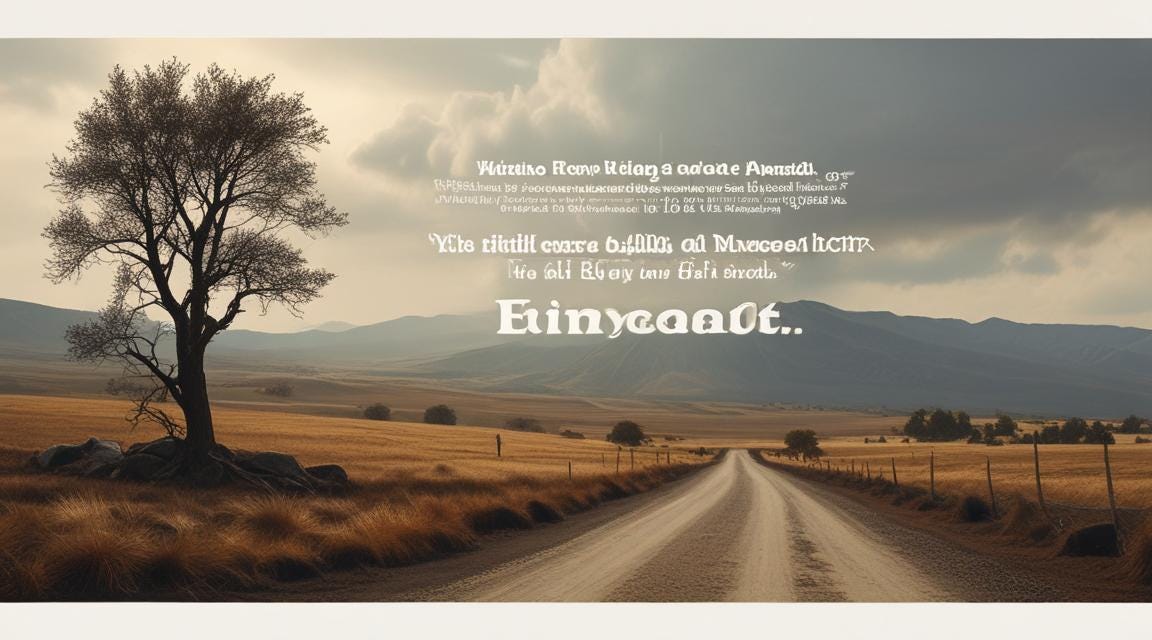Today marks a significant celebration in India—the victory of Prince Rama, the revered incarnation of the Preserver-God, over the demon-king Ravana.
This day symbolizes the triumph of good over evil after a fierce ten-day battle between the two forces.
Have you ever wondered why this story1 has endured for so many centuries?
What makes Rama's victory such a timeless symbol of virtue and hope that good will overcome evil?
Let's explore some key moments that shaped this epic journey. Here is my modern retelling of the significant episodes of Rama's life:
How Rama came to be exiled!
The love story of Rama and his Princess wife, Sita
How Sita was kidnapped!
The path of good intentions that led to the making of an evil-king.
Cultural Context
The story of Rama has fascinated both believers and non-believers throughout history. The oldest parts are believed to have been written in the 7th century BCE.2
The story is believed to have occurred during the second multi-thousand year period known as ‘Treta Yuga.’
There are at least 48 versions3 of the main story in global languages, including Japanese, Laotian, Tibetan, Old Javanese, Persian, Malaya, Burmese, Maranao, and Thai, in addition to various Indian languages and English.
All versions trace the original stories to the earliest accounts - Valmiki’s Ramayana, and a 17th-century retelling by the famous saint, Tulasidas.
Western and Indian artists4 have depicted the various scenes of the story innumerable times, through the centuries, and retelling it in English as well.
During these ten days, scenes from the story are enacted in many parts of India. On the tenth day (i.e. today) especially in the North, effigies of the ten-headed demon king and his evil brothers are shot with burning arrows or set on fire5 to celebrate Rama’s victory.
The largest and most famous of these celebrations is held in Delhi on grounds named 'Ramlila,'6 where people of all ages come together to witness the dramatic spectacle: Rama has once again defeated the evil king and avenged his honor after his beloved wife was kidnapped.
In the South and Western states of India, the young offer leaves of a sacred tree to the elderly for their blessings. The phrase 'May the leaves turn to gold' is often used to symbolize the wish for good fortune.
For today's wisdom series, I have chosen three stories from this ancient tale.
The Good Brother
Ravana’s brother, Vibhishana, was known to be a down-to-earth Prince, spiritual in nature, and observer of ethical boundaries.
Unfortunately, every piece of advice he gave to his older brother came to naught, as the king was drunk with lust, greed, and the power gained through his boons from the Gods.7
Once, a man approached Vibhishana for help as he was unable to cross the river near his village. He could not swim, and there were no boats. The prince listened to his fears, and agreed to help.
He wrote something down on a piece of paper, folded it, and gave it to the man, saying, “Carry this with you, and you will be able to cross the river easily. But at no time must you open this paper or look inside.”
The man agreed, reached the bank of the river, closed his eyes, and stepped forward, holding the paper tightly.
To his surprise, he found that he could walk—the river was no different from land.
He began to wonder about the power of the paper that Vibhishana had given him.
At first, as he walked gingerly to the middle of the river, gripping the paper tightly, his heart pounding with both fear and excitement, keeping his promise was easy.
But soon his mind started to wonder: What could be so powerful about a simple piece of paper that allowed him to cross the river so easily ?
Three-fourths of the way across, his curiosity got the better of him.
He opened the paper and saw that it had just one word written on it—'Rama.'
“Is this all?” he thought with disdain. No sooner had he doubted it than he fell into the river and was swept away.
Such is the power of the name of Rama, the ancients suggest, but only for those who have faith. Vibhishana’s faith was so great that he enabled another man to walk on the river with its power. Yet, when that man lost faith, he promptly drowned.
The Devoted Ascetic Woman
Once upon a time, in the age of Rama, a woman ascetic lived in the forest. Her guru, whom she had served with devotion, had blessed her, telling her that Rama would one day pass by her hut, though he did not specify when.
Trusting her guru’s words, she resolved to wait for Rama and seek his blessings.
Each day, she would awaken, clean both inside and outside her hut, gather the best fruits—the Indian jujube—from the forest, prepare bowls from the leaves of a nearby tree to hold the fruits, and wait patiently for Rama to appear.
“Perhaps today is the day Rama will come,” she reasoned daily.
When the day passed without any sign of Rama and evening fell, she retired to her simple hut, still hopeful that the next day might bring her the sight of her beloved prince.
Years passed. Youth turned to old age. Her back bent, her hair silvered, and she needed a stick to walk. Yet she continued her routine.
Each day, she cleaned her hut, gathered the fruits, and waited, watching for a sign of Rama.
Finally, one day, the exiled prince, in search of his kidnapped wife Sita, ventured deeper into the forest and saw the hut—a sole anchor in the vast wilderness.
He approached, hoping for any news that might aid in finding Sita.
The old woman stood in shock. “Who is this handsome man, his face shining like the sun, accompanied by another who stands guard, seeking information from me?” she thought.
Unable to trust that the decades of waiting had been rewarded, she asked him to introduce himself.
“Mother, I am Rama, the son of Dasharatha, and this is my brother, Lakshmana,” replied the elder prince softly.
The woman hugged him, her eyes welling with tears of happiness.
Her voice trembled as she invited the two of them inside.
The sounds of her hurried footsteps filled the small hut. In her excitement, she almost forgot the routine she had planned for years, her hands shaking slightly from the overwhelming emotion.
Rama had come at last!
First, she brought water for them to wash their feet, then quickly fetched straw mats to lay on the floor.
She motioned for Rama and his brother to sit.
Then she brought her carefully selected bowl of fruit, set it down, and sat at Rama’s feet.
She offered them to him, but when he reached for it, she stopped him.
Instead, she picked a fruit, bit off a piece, and if it was bitter, she threw it away.
She picked another, bit it, and, satisfied with its sweetness, offered it to Rama.
The younger prince shocked, stood up abruptly, his face flushed with anger. His eyes narrowed as he glared at her, disbelief etched across his features. “How dare she?” he thought to himself. “Did she not know who she was offering it to?” His body trembled with indignation, unable to comprehend her actions.
But Rama sat calmly, smiling, and motioned to his angry brother to sit down.
The woman had barely noticed, as she was busy selecting the next piece.
When she left briefly got up to get more fruit, Rama spoke softly to his brother, “Dear Lakshmana, I know that you are agitated for my sake. You noticed her actions, but you failed to see the love and devotion behind them.”
Amazed at Rama’s response, the younger prince learned a valuable lesson that day—what mattered to Rama, the peerless One, was the depth of love a person had for him.
In visiting and eating the bitten fruit of a poor ascetic woman in the forest, Rama had honored her devotion above that of the many wise sages who yearned for a glimpse of him.
The Wooing of Sita
Ravana kidnapped Sita and held her captive for more than ten months.
Despite her difficult circumstances, Sita showed immense strength and refused to enter his palace. She demanded to live in a garden on the outskirts of the palace under a grand old tree, resolute in her refusal to marry him.
Ravana tried countless ways to woo her, sometimes disguising himself as a handsome prince, his pride driving him to seek her acquiescence and to make her his bride.
But Sita saw through every disguise, her devotion to Rama remained unwavering.
One day, an advisor said to Ravana, "Why try so many different disguises? Just take the form of Rama, and Sita will accept you."
Ravana shook his head. "I cannot. The second I take Rama’s form, all thoughts of lust leave my mind. I cannot covet another man's wife, and all thoughts of sin leave my heart.”
Such is the purity of Rama, the ancients suggest, that even Ravana, could not be untouched by it.
Conclusion
The stories of heroes everywhere revolve around themes of courage, duty, honor, sacrifice, devotion, love, and triumph.
They transcend the ages, highlighting the importance of facing challenges with resilience, honoring our duties, and remaining steadfast in our beliefs.
They also remind us never to lose faith; no matter how dark the night, good will ultimately prevail.
p.s. I hope you enjoyed this take! Read my other wisdom series posts here.
According to Robert Goldman, Sanskrit Professor, University of California at Berkeley who translated Ramayana in English (Princeton Press).
Ramlila = 'play (lila) of Rama.'
Ravana received the gift of immortality, and he was so drunk with power that the only species he did not seek protection from was humans. Hence, Rama was born as a human to defeat him.








Prince Rama reminds me of Michael The Archangel, who battles Satan the evil deceiver. Thank you Jayshree for sharing these wonder East Indian sculptural and spiritual stories.
✨💜✨🙏